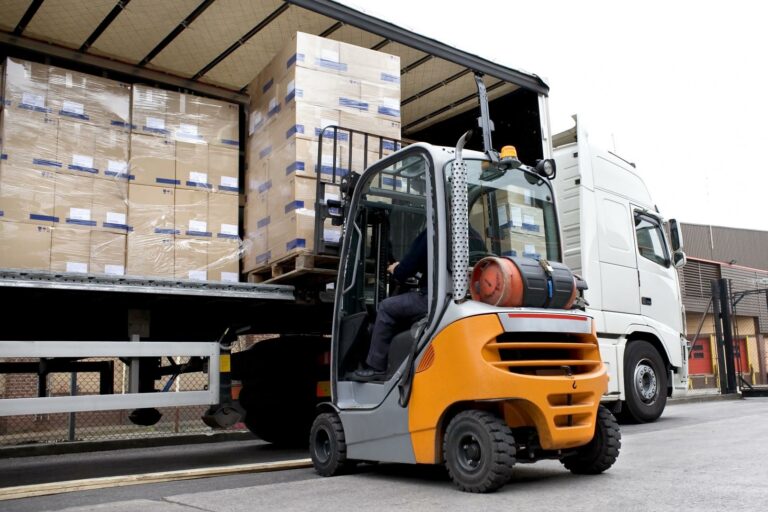When a vehicle changes speed or direction or drives over obstacles, dynamic forces act on the load that can cause it to slip, fall over or drop. As a result, the vehicle can spin out of control or tip over, causing the load to fall onto the road or injure the driver and others. Correct load securing should prevent exactly this.
Whether a load slides forward due to its inertia during braking depends on the magnitude of the acceleration – braking here corresponds to negative acceleration – and thus the force acting on the load. Load securing should counteract these forces and prevent the load from sliding.
Common rumours on cargo security
There are many errors that lead to a certain carelessness when it comes to load securing, especially among the inexperienced. In practice, for example, you often hear the sentence “The load is so heavy, it can’t slip at all”. Wrong! Whether cargo slides or not is independent of its weight. The securing forces that hold the cargo on the loading area must be greater the heavier it is.
The assumption that heavy loads cannot tip is also wrong. Whether a load tips or not is independent of its weight. The only decisive factor is the position of the centre of gravity in relation to the tipping edge.
“After all, my load is held laterally by the tarpaulin”. This assumption can also have fatal consequences in the event of an accident. Of course, vehicle tarpaulins are not load securing devices.
These are just three misconceptions – in reality there are many rumours about load securing… and many are false. On the other hand, however, there are some basic rules that should be observed when securing loads.
The 6 basic rules of load securing
- Depending on the load, a suitable vehicle is required, which is capable of safely absorbing the forces arising from the load by means of its body and equipment.
- The centre of gravity of the load should be on the longitudinal centre line of the vehicle if possible and should be kept as low as possible.
- Heavy goods below, light goods above.
- Do not exceed permissible total weight or permissible axle loads. Do not fall below the minimum axle load of the steering axle.
- When partially loaded, ensure weight distribution so that each axle is loaded proportionally. The load distribution plans provided by the vehicle and body manufacturers must be taken into account.
- Adjust the driving speed to the road and traffic conditions as well as to the driving characteristics of the vehicle, depending on the load.
Force-fit load securing – no more slipping
With friction-locked securing, the load units are positioned in such a way that it is impossible for the cargo to slip. For example, the cargo is placed against the front wall of the transport vehicle and the gaps are filled with empty pallets. Direct lashing and diagonal lashing also belong to the category of form-fit securing. For diagonal lashing and direct lashing, various aids are available to those responsible. With lashing chains, lashing wire ropes and lashing straps, the load is successfully protected against shifting with this type of securing.
Part of the required securing forces can be applied by the friction between the load and the loading surface alone. The greater the frictional force, the lower the effort required for other load securing, as the frictional force already represents part of the safety forces to be applied.
Friction can be increased by lashing down, using anti-slip mats or simply cleaning the loading area.
Form-fitting load securing – gapless loading
The principle of form-fit load securing is more effective than force-fit load securing. Loading is done in such a way that there are no gaps between the individual load parts. Particular attention must be paid to the maximum load-bearing capacity of the end walls and drop sides.
A tight fit can also be achieved by directly connecting a lashing (lashing strap) between the load and the vehicle body. This means that lashing points must be provided both on the vehicle and on the load.
Blocking of the load is understood to mean the positive locking of the load on the loading area either by the vehicle superstructure itself or by various aids, such as wedges embedded in the loading area.
In practice, combinations of load securing are often used (e.g. diagonal lashing).
Load securing aids – with examples
Here are some examples of common cargo safety material:
- Anti-slip mats
- Lashing equipment and lashing points
- Locking bars and locking beams
- Coil troughs
- Anchor rails
- Nets and tarpaulins
- Slip-resistant intermediate layers
- Wooden wedges
- Loading racks
- Filler to close loading gaps
- Walls of the vehicle
The practical manual on cargo safety
There are several manuals on the subject. Prof. Hermann Knaps has created a comprehensive guideline for GDV Insurance that you can download here: Guide to cargo safety in road freight transport.











